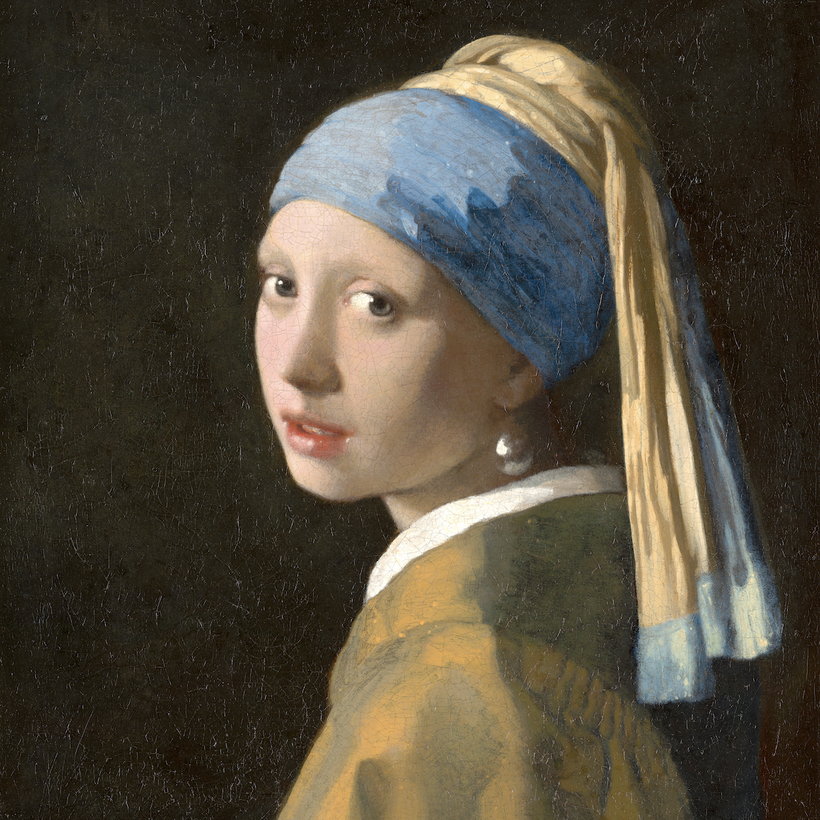It is only fair to preface what follows by recognizing that there is something irritating, some might say hostile, about recommending an exhibition that is reportedly sold out, not on for long, and out of the way. But: the trance-like morning I spent at “Vermeer” at the Rijksmuseum—just “Vermeer,” not “Vermeer’s Women,” not “Vermeer Landscapes,” not “Vermeer and Dairy,” with no qualifying subtitle at all—was the greatest single-artist show I have seen or may ever see.
The level and consistency of quality was astonishing, the display faultless, and the quantity unlikely to be equaled. Of the 37 paintings attributed to the 17th-century Dutch master—that is, according to the Rijksmuseum; the National Gallery in Washington sets the number at 34—28 are assembled. It is the mark of the curators’ rare and magical achievement that one can name and count on two hands those works that were not included, notably The Art of Painting (circa 1666–68; Kunsthistorisches Museum, Vienna).

Three decades ago, the last—and less comprehensive—Vermeer blockbuster was mounted in Washington and The Hague, running from 1995 to 1996. In the years prior, the Rijksmuseum had never dedicated its galleries to Vermeer. To rectify these generational and institutional gaps, loans were negotiated from New York (three courtesy of the Frick Collection, currently under renovation), The Hague, Washington, Edinburgh, Dublin, London, Paris, Berlin, Tokyo, Dresden, and Frankfurt.
Arranged in roughly chronological and thematic order, “Vermeer” unfolds in self-contained rooms, each of which has its own special character. In the first are two limpid visions of Delft, where the painter lived, practiced, and died. When the unrivaled collection of Pieter van Ruijven, Vermeer’s local patron, was auctioned, in 1696, View of Delft (1660–61) achieved 200 Dutch guilders, the session’s highest price. (The Milkmaid, from 1657–60, came in second at 175 guilders.)
The trance-like morning I spent at “Vermeer” at the Rijksmuseum was the greatest single-artist show I have seen or may ever see.
Four larger, earlier religious and mythological scenes close by show the artist’s technically stiffer, more conventional beginnings. Saint Praxedis (circa 1655) is the last Vermeer to appear publicly for sale; in 2014, it realized $10.7 million at Christie’s in London.
Vermeer found his métier—the play of light, silence, and restraint—in the latter part of the 1650s. In Girl Reading a Letter at an Open Window (1657–59), it is all there: the framing of the window, curtain rail, and fabrics; the balance and just-so tonality; the subtle backdrop in the previously overpainted cupid on the back wall; and the figure’s erect, solitary absorption.

The Milkmaid hangs separately. The space, although teeming with determined visitors, was almost perfectly quiet. It is the sort of painting in front of which time stands still. The sensation is of tranquility and tension, between the smooth and the textured brushwork of her face; between solid forms and intricate detail; between the spareness of the wall and the depth of the apron’s blue; between private thoughts and physical activity; between the fleeting and the permanent.
The level and consistency of quality was astonishing, the display faultless, and the quantity unlikely to be equaled.
The Frick’s Officer and Laughing Girl (1657–58), with its richly attired caller, the sliver of the outside world to be glimpsed through the window, and crisply rendered map, is blaringly cosmopolitan by contrast.
Girl with a Pearl Earring (1665), on view until its early return to the Mauritshuis at the end of the month, is practically inextricable from its everyday reproductions and cultural fame. In person, its heavenly beauty cannot be overstated. Much has been said about the softness and delicacy of her features. I was just as taken with the background’s glassy, varnished surface—with light catching the dense networks of drying cracks—which oddly heightens the transfixing effect.

What, in the end, does one leave with? The Lacemaker (1669–70) inspired in me powerful feelings of craft; Woman with a Pearl Necklace and Woman Holding a Balance (both circa 1662–65), the desire to live simply and virtuously; The Geographer (1668–69), to strive for greatness. I remained the longest and with the purest gratification peering at Woman in Blue Reading a Letter (1663) and its scarcely perceptible intermingling of blue and yellow in the reader, chairs, and shadows.
In 2011, I bored, and possibly disturbed, friends and family with unsought ravings about “Leonardo: Painter at the Court of Milan” (note the subtitle) at the National Gallery in London, in which 9 of the 20 Leonardos in existence were gathered together. I felt then that the experience could not be surpassed. I was mistaken.
“Vermeer” is on show at the Rijksmuseum, in Amsterdam, through June 4
Max Carter is vice-chairman of 20th- and 21st-century art at Christie’s in New York

